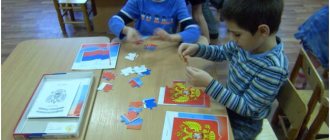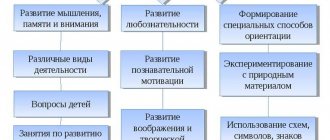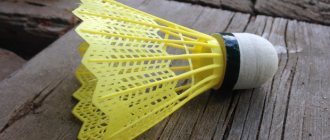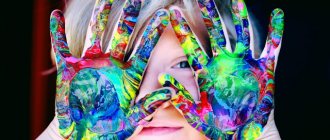MAGAZINE Preschooler.RF
Organization of motor activity of a preschooler in the daily routine.One of the most important tasks of our society is the formation of a viable, healthy younger generation.
Currently, in conditions of unfavorable environmental conditions and unstable social conditions, the problem of children's health is especially pressing.
One of the factors shaping a child’s health is physical activity. It is defined as the number of movements that the baby makes during the entire wakefulness.
Motor activity is understood as the total number of motor actions performed by a person in the process of everyday life.
Physiologists consider movement to be an innate, vital human need. Its complete satisfaction is especially important in early and preschool age, when all the basic systems and functions of the body are formed.
Doctors say that without movement, a child cannot grow up healthy. Movement, by their definition, can act as a preventative measure. In addition, movement is widely used as an effective therapeutic and corrective tool.
Physical activity has a positive effect not only on children’s health, but also on their overall development. Under the influence of movements, the emotional, volitional, and cognitive sphere of the baby develops.
Research by N. M. Shchelovanova and M. Yu. Kistyakovskaya shows: the more varied the movements a child performs, the richer his motor experience, the more information enters the brain, which contributes to more intensive intellectual development of the baby.
A variety of movements, especially if they involve the work of the hands, have a positive effect on speech development. (M. Koltsova).
Movement is a means of understanding the surrounding world and satisfying the biological needs of the body. It is difficult to overestimate the role of physical activity in expanding the functional capabilities of the developing organism and in improving motor activity. But lack of movement can lead to pathological changes in the body. According to regulatory documents regulating sanitary and epidemiological rules and regulations for preschool educational institutions, the maximum duration of continuous wakefulness for children 3-7 years old is 5.5-6 hours.
It is very important to rationally organize the regime in kindergarten so that children are in motion as much as possible. Physical education and health activities in kindergarten are carried out daily in accordance with the physical activity schedule. Their implementation is monitored according to the plan. The forms of physical education and health work have become more diverse.
In our preschool, in addition to morning exercises, exercises are carried out after sleep - “awakening exercises” . The exercises begin from a lying position, then sitting and gradually the children get up, doing the exercises near the bed. In addition, the preschool institution hosts sports and recreational activities and physical education events.
For hardening the body, regular physical training in order to improve the muscular system and respiratory system, morning exercises are very important. It is carried out in various forms: traditional, games, gymnastics using various objects.
A positive healing effect is possible with regular organized physical activity, which takes into account the principles of gradual, repeatable and systematic physical activity. Exercises to improve posture and develop spinal flexibility are mandatory.
To prevent fatigue and decreased performance, dynamic breaks are used. They help relieve tension in children during prolonged static stress. We also conduct physical education, finger and body games.
During the day, the walk is organized twice: in the morning and in the evening. A walk is a favorable time for carrying out individual work with children and organizing their independent physical activity. Games for the walk are selected taking into account the age of the children. Games should include various types of movements (running, throwing, jumping, etc.) and contain interesting motor game tasks.
Dosed running and walking for a walk is one of the ways to train and improve endurance, the most valuable health quality.
Relaxation exercises should be performed before napping. They are used to relieve tension in muscles involved in various activities.
In the second half of the day, more time is devoted to children’s independent motor activities, organized without the explicit intervention of the teacher. At the same time, it is necessary that children have at their disposal aids that stimulate a variety of physical activities. A physical education corner with a set of sports equipment (balls, hoops, bags, cords, ropes, ribbons, handkerchiefs, ribbed boards, etc.), caps for outdoor games, mats for the prevention of flat feet, a health track.
So, there is no task more important and at the same time more difficult than raising a healthy person. Raising a healthy child has been and remains a pressing problem in education and medicine. This problem in our kindergarten is solved through the interaction of teachers and parents. After all, a child’s health largely depends on the environment that surrounds him at home.
With proper organization of physical activity in the family and in kindergarten, the child grows and develops in accordance with his age. He has a good appetite, sleep, balanced behavior, positive forms of communication with adults and peers. His activities are varied and age-appropriate.
Literature:
1. Avchenko N. Honorary worker of general education of the Russian Federation, physical education teacher, child development center - kindergarten No. 2347, Moscow.
Journal "Preschooler's Health" No. 5, 2009, p. 18.
“How physical education affects the mental development of a child”.
2. Kirsanova N.V., teacher of the State Educational Institution of Secondary Professional Education, Penza Pedagogical Institute, Penza.
Magazine “Management of Preschool Educational Institution” No. 5, 2007. “Motor activity while walking in winter” , p. 76.
3. Makarova L.I., Ph.D. honey. Sciences, senior lecturer; Pogorelova I.G., Associate Professor, Department of Municipal Hygiene and Hygiene of Children and Adolescents, Irkutsk State Medical University, Irkutsk. Magazine "Physical Education Instructor" No. 2, 2010, p. 12.
“Motor activity in the full development of the child’s body”.
4. Osokina T.I. Physical education in kindergarten. — 3rd ed., revised. - M.: Education, 1986. “Methodological recommendations for outdoor games and physical exercises while walking ,” pp. 35, 79, 127, 194, 257.
5. Runova M.A. Motor activity of a child: A manual for teachers
| Next > |
Creating an optimal motor mode in kindergarten
Lydia Miroshnichenko
Creating an optimal motor mode in kindergarten
Goal: Creating conditions for the development of motor activity and the health of the child through close interaction between the kindergarten , family and society.
When developing a rational motor regimen, it is important , in my opinion, not only to ensure that children’s biological needs for motor activity , but also to provide for a rational content of motor activity , based on the optimal ratio of different types of activities, selected taking into account age and individual characteristics. The motor activity of a preschooler should be directed and consistent with his experience, interests, desires, and functional capabilities of the body, which forms the basis of an individual approach to each child. Therefore, as a teacher, I need to take care of the organization of children’s motor activity , its diversity, as well as the fulfillment of the main tasks and requirements for its content. The content side of the motor regime of preschoolers should be aimed at developing the mental, spiritual and physical abilities of children.
Attaching particular importance to the role of physical activity in promoting the health of preschool children, it is necessary to determine priorities in the daily routine .
The first place in the motor mode of children belongs to physical education and recreational activities. This includes well-known types of physical activity : morning exercises, outdoor games and physical exercises during walks, physical education sessions during exercise with mental stress, etc.
The second place in the motor mode of children is occupied by ECD in physical education - as the main form of teaching motor skills and developing optimal motor activity in children . I recommend conducting ECD in physical education at least three times a week in the morning (one in the air)
.
Third place is given to independent motor activity that occurs on the initiative of children. It gives wide scope for the manifestation of their individual motor capabilities . Independent activity is an important source of activity and self-development of a child. Its duration depends on the individual manifestations of children in motor activity .
Forms of work:
September
Section for self-education: Studying the individual characteristics of children in different types of physical activity and implementing on this basis the principle of an individually differentiated approach.
With teachers: Studying literature.
With children: Studying the characteristics of motor activity of children 6-7 years old. (reading specialized literature)
With parents: Questionnaire.
October
Section for self-education: Studying the individual characteristics of children in different types of physical activity and implementing on this basis the principle of an individually differentiated approach.
With teachers: Drawing up recommendations for teachers on the dynamics of changes in children’s physical activity
With children: Study of daily fluctuations in physical activity and weekly dynamics of physical activity
With parents: A survey of society and making recommendations for parents on where it is better to enroll their child.
November
Self-education section: Studying morning exercise complexes.
With teachers: Compiling a card index of exercise sets for each academic month.
With children: Carrying out sets of exercises with children (one set of exercises for 1-2 weeks)
With parents: Drawing up recommendations for parents on morning exercises at home
December
Section for self-education: Study of motor warm-ups and physical education exercises.
With teachers: Compiling a card index of physical education minutes and motor warm-ups
With children: Conducting physical education and motor warm-ups
With parents: Drawing up recommendations for parents on what semi-active games you can play with your child at home.
January
Section for self-education: Outdoor games and physical exercises while walking in the cold season.
With teachers:
1. Consultation for educators: “morning exercises for senior preschool age”
.
2. A selection of outdoor games and exercises while walking during the cold season.
With children: Carrying out outdoor games and exercises in the cold season.
With parents: Drawing up recommendations for parents on how best to organize a walk for children in the winter season.
February
Section for self-education: Studying methods of individual work on movement development.
With teachers:
A selection of literature for studying methods of individual work on movement development.
With children: Conducting individual work with children
With parents: Drawing up recommendations for parents “ Motor activity of an older preschooler”
.
March
Section for self-education: Studying gymnastics complexes after a nap in combination with contrasting air baths
With teachers: Reading literature. Selection of gymnastics complexes after a nap.
With children: Carrying out gymnastics after a nap.
With parents: Drawing up recommendations for parents “ Motor activity of an older preschooler”
.
April
Section for self-education: Independent motor activity of children
With teachers: Studying literature on the organization of independent motor activity of children
With children: Analysis of independent motor activity of children .
With parents: Consultation for parents on the topic: “Independent motor activity of children ”
May
Section for self-education: Outdoor games and physical exercises while walking in the warm season
With teachers: Studying literature. Compiling a card index of outdoor games in the warm season for older preschoolers.
With children: Carrying out outdoor games and exercises.
With parents: Drawing up recommendations for parents: “Playing with children outside in the warm season”
June August
Section for self-education: Summer hardening activities. Development of a long-term plan for activities with children. Summing up the study of the topic. Drawing up recommendations for teachers and parents on the topic studied.
With teachers: Studying literature. Development of complexes of summer hardening procedures. Preparation of instructions for teachers on working with the physical activity of children . Consultation: “ Motor activity of children in preschool settings”
With children: Behavior-friendly tempering activities for preschoolers. Study of technologies by O. V. Kozyreva, M. Yu. Kartushina. Drawing up a model of motor activity for children
With parents: Drawing up recommendations for parents on hardening activities during the warm season. Preparation of instructions for parents on the regime for children at home . Familiarization of parents with the model of motor activity of children in kindergarten .
The forms of organizing health-improving work, in my opinion, are: independent activity of children, outdoor games, morning exercises, motor-health-improving physical training minutes , physical exercises after naps, physical exercises in combination with hardening procedures, physical exercise walks (to the park, to the forest, to pond, physical education, sports events, health days, wellness treatments in the aquatic environment (swimming pool)
.
The first stage of the pedagogical process - “Morning” - is the most saturated with educational and health-improving tasks. In the morning we try to plan games of low or medium activity. But at the same time, when planning outdoor games, we definitely take into account what activities will happen after breakfast. If classes are associated with long-term static posture (mathematics, speech development, fine arts), then we plan games of medium and greater mobility. If there is direct educational activity, then we plan a calmer final game.
To harden the body, increase the performance of children after sleep and regular physical training in order to improve the muscular system and respiratory system, morning exercises are very important. We conduct it in various forms: traditional, game, gymnastics using various objects, rhythmic gymnastics.
A positive healing effect is possible with regular exercise, which takes into account compliance with the principles of gradual, repeatable and systematic physical activity. Mandatory for each lesson are exercises to improve posture and develop spinal flexibility. An indispensable condition for conducting ECD is constant monitoring of the well-being of children. All exercises are performed against the backdrop of positive responses from the child.
To prevent fatigue and decreased performance, we perform dynamic breaks. They help relieve tension in children during prolonged static stress. We also conduct physical education, finger and body games.
The 2nd stage of the pedagogical process is “Walk”. During the day, the walk is organized twice: in the morning and in the evening. A walk is a favorable time for carrying out individual work with children and organizing their independent physical activity .
Teachers are responsible when planning outings, carefully selecting games for outings taking into account the age of the children. Games should include different types of movements (running, throwing, jumping, etc.)
and contain interesting
motor game tasks .
Preschool children enjoy playing story games and games with objects. Among older preschoolers, games such as relay races, games with rules, and elements of competition are popular. Dosed running and walking for a walk is one of the ways to train and improve endurance, the most valuable health quality. At the beginning or end of the walk, it is recommended to jog, for example, around the kindergarten (speed 1-1.2 m/s, and then start walking.
Relaxation exercises should be performed before napping. They are used to relieve tension in muscles involved in various activities.
3rd stage of the pedagogical process “Afternoon”.
kindergarten tomorrow . To implement it, the teacher creates a positive emotional mood in the group.
After naps in each group, teachers conduct invigorating gymnastics. It consists of 4-6 exercises that children perform while lying or sitting in bed on top of a blanket. In older groups, teachers add self-massage. Children wake up, then do exercises in bed, then stand on massage mats and follow the “health paths” located on the floor to the washroom.
In the second half of the day we try to devote more time to children’s independent motor activity . Here we are helped by physical education corners, which are available in all groups.




